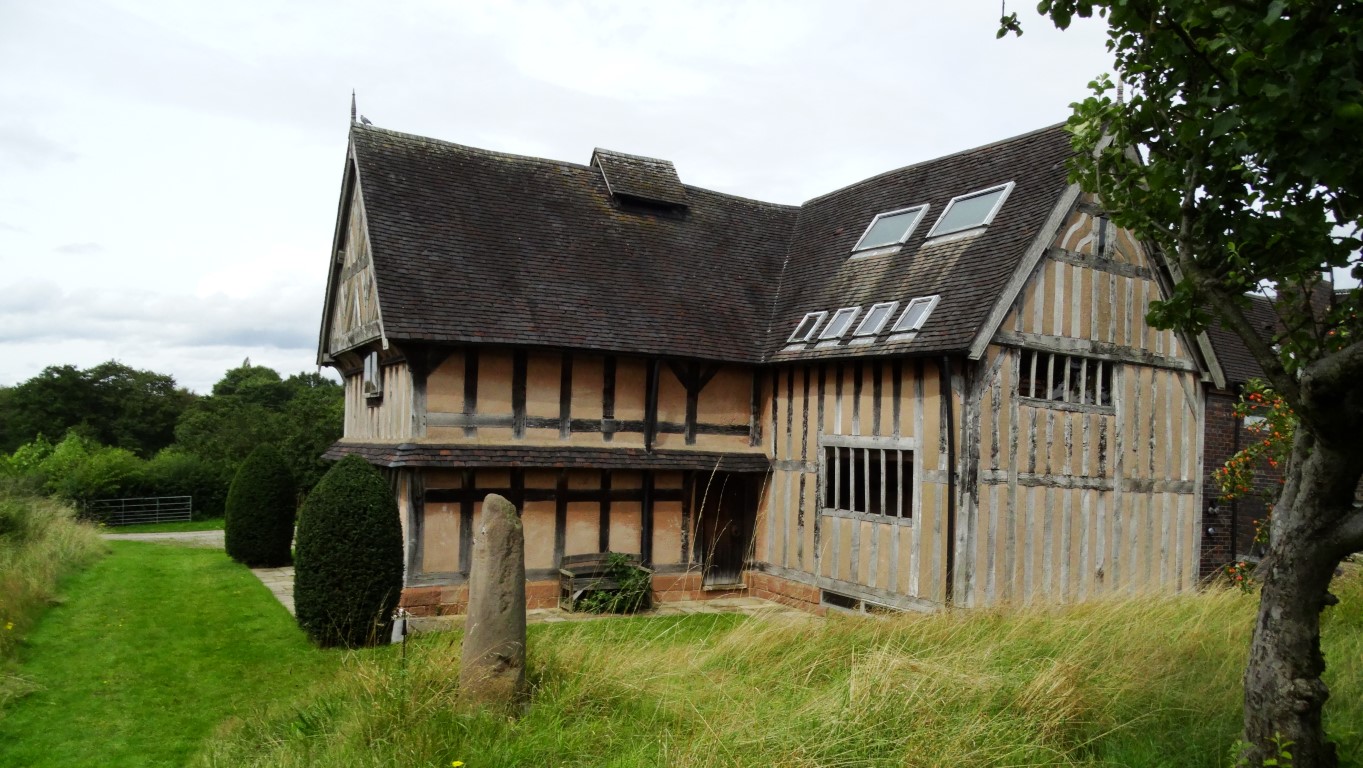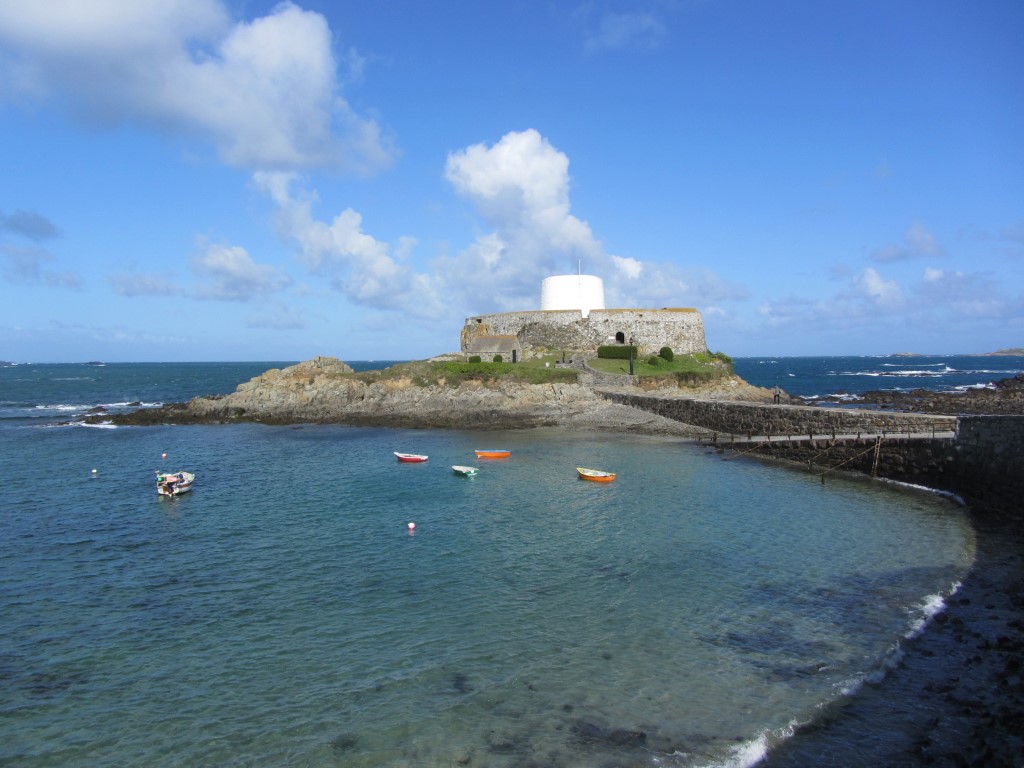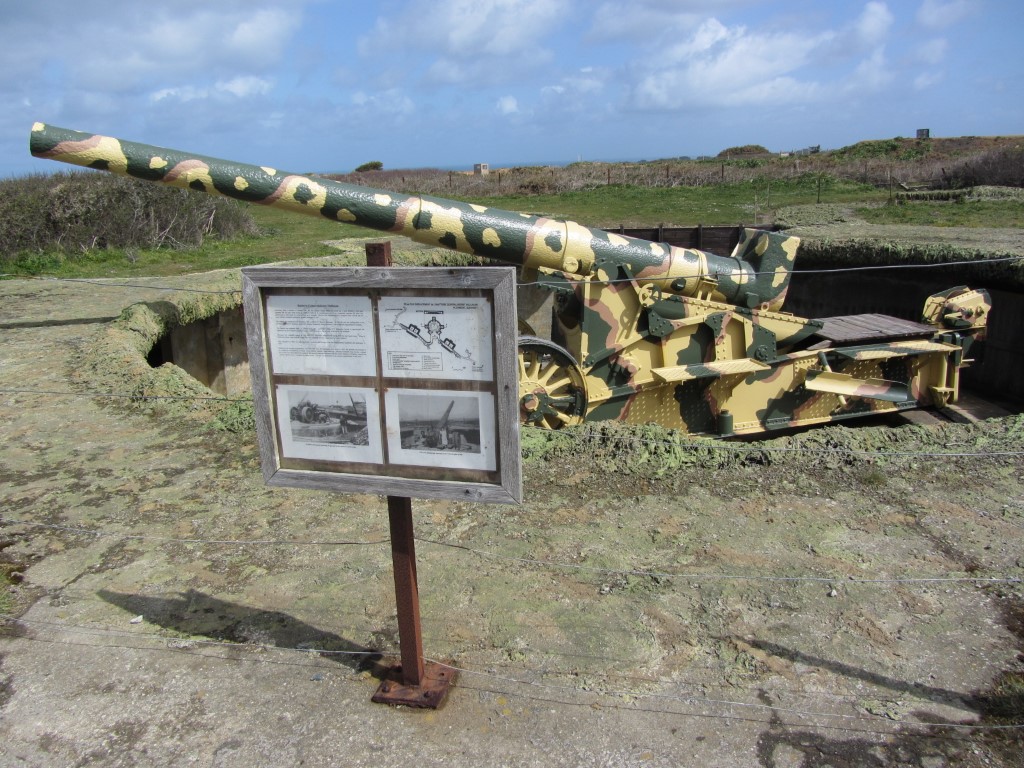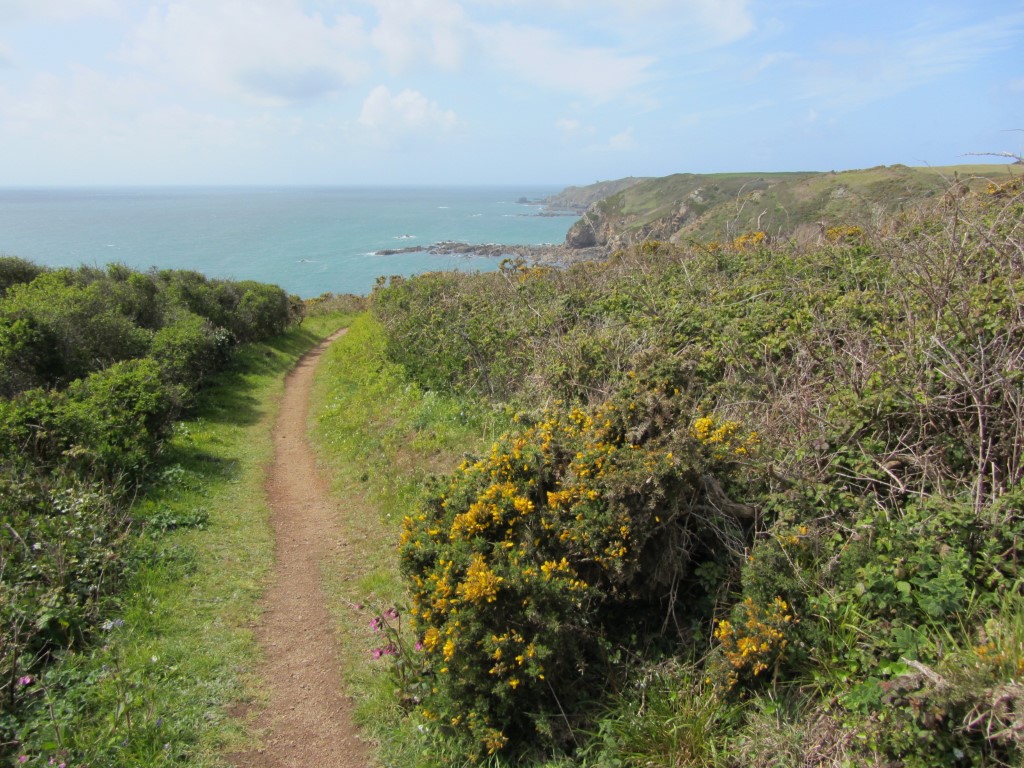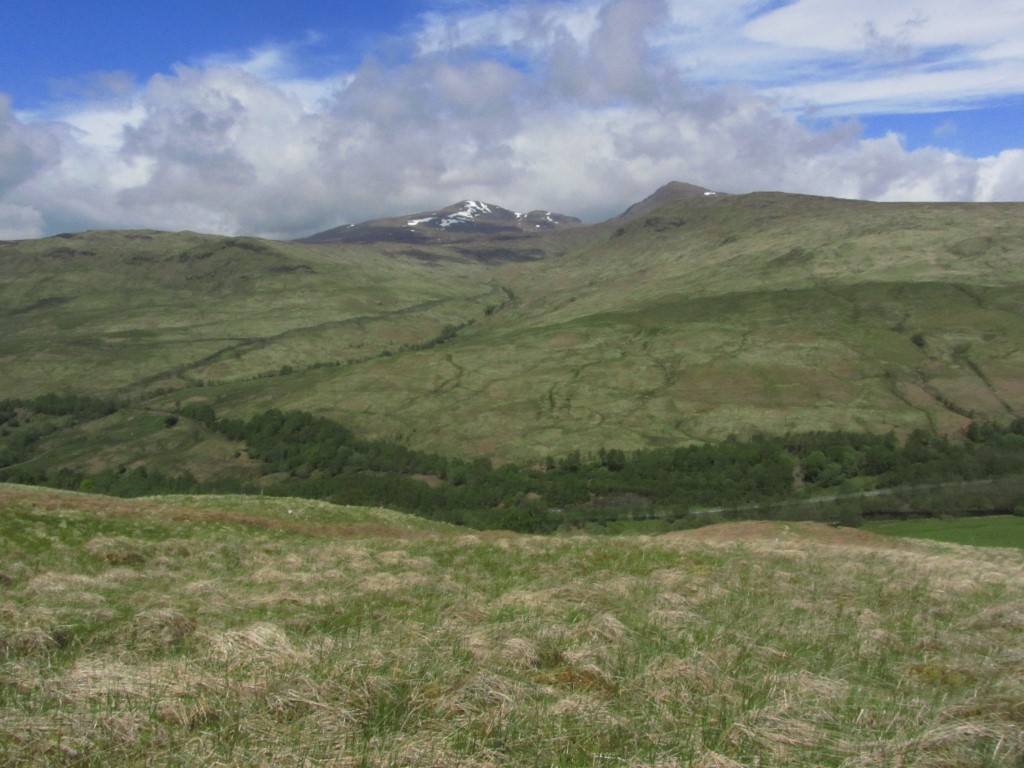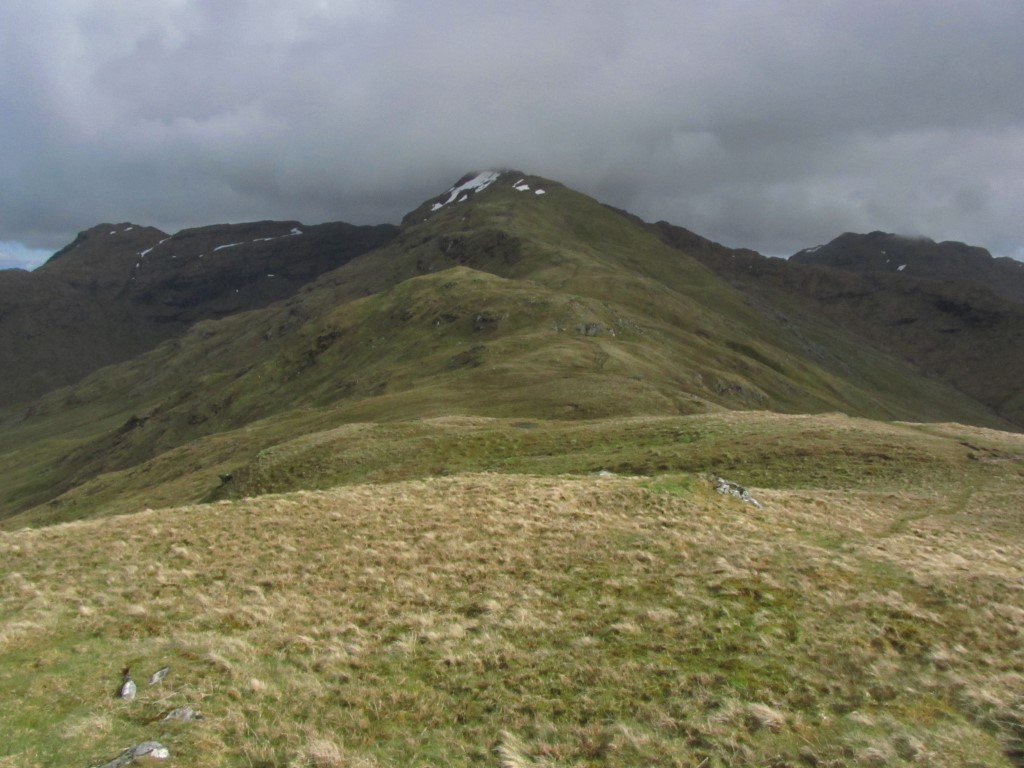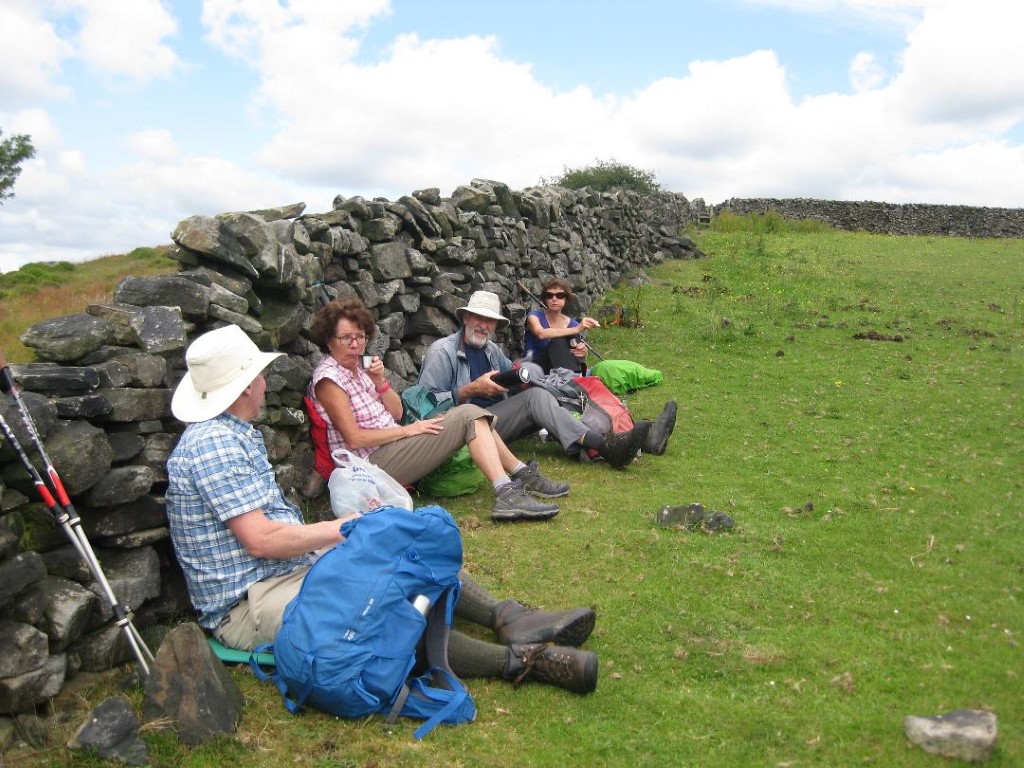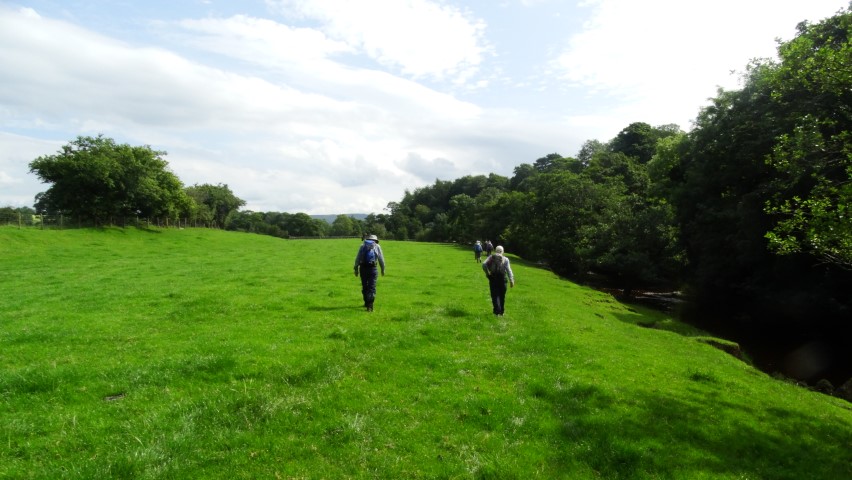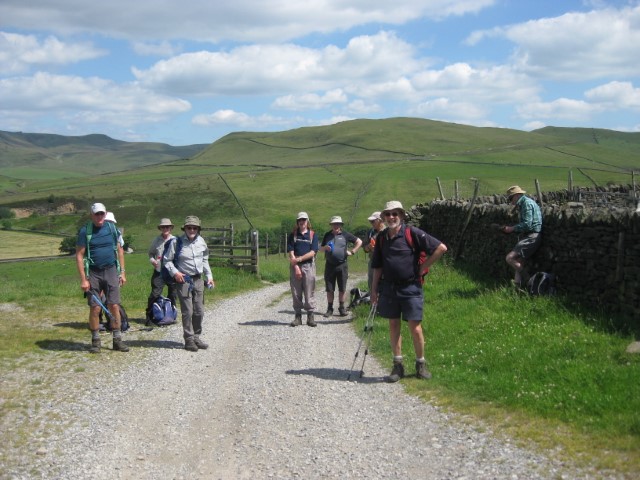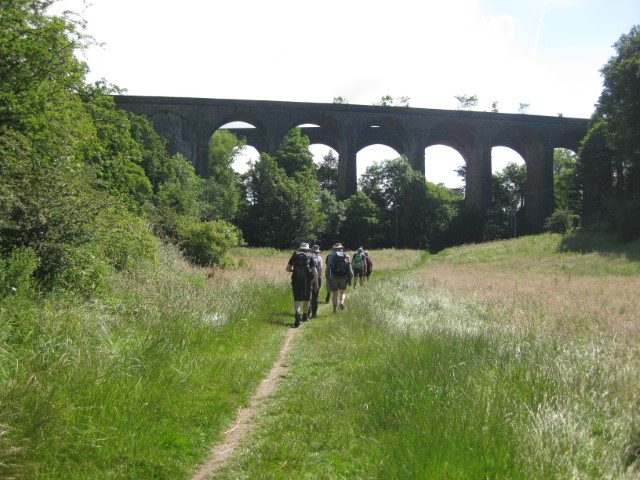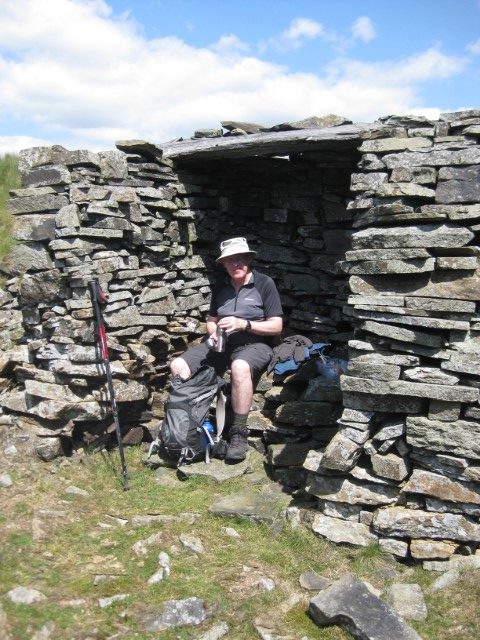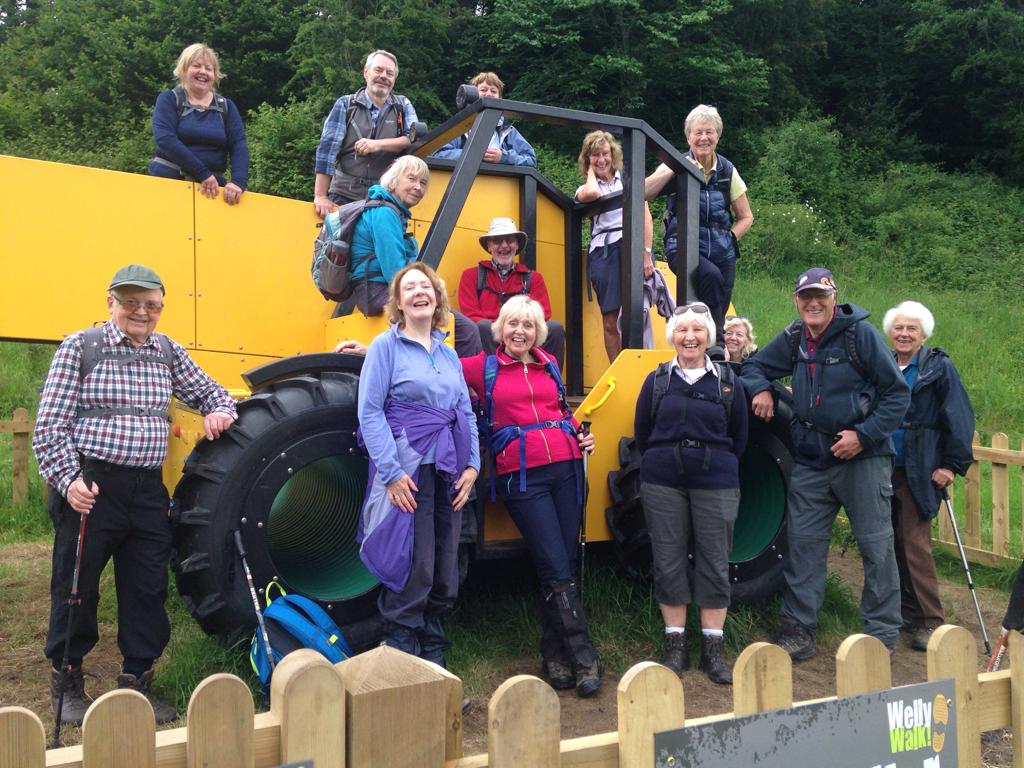During a walk I led through the Goostrey area early in 2019 we ‘stumbled’ upon some signs pointing to ‘The Blackden Trust’. On closer inspection, the track led up to an attractive old half timbered building.
Some research afterwards found this to be a local ‘hidden gem’, a re-located Tudor House tucked away in the Cheshire countryside on land which had been inhabited for ten thousand years.
After some enquiries ,Brain Griffiths and I decided toorganise a visit to this house during the summer months, which as it turned out proved so popular that in the end we organised three trips which included a short morning walk locally followed by a visit and conducted tour on what is called The Old Medicine House and the surrounding gardens followed by afternoon refreshments. Thankfully, the weather was fine for all three visits.
The Old Medicine House belongs to The Blackden Trust, a registered charitable trust, founded by Alan and Griselda Garner and their friend, Patsy Roynon.
Our visit was to The Old Medicine House and its gardens. The building which was originally at Wrinehill, southeast of Crewe was due for demolition back in 1970 despite it being a Grade II building. The building was rescued by Alan Garner who bought the house for £1. It was dismantled and rebuilt adjacent to the historic half timbered Toad Hall, where the Garner family has lived since 1957.
The building is a three bay timber-frame structure and dates from around the early 16th century. Our tour started with a short slide show depicting the construction and history of the house before we were split into smaller groups where volunteer guides showed us around the rooms giving us a detailed insight into the history of each room including items which have been discovered in the re-building of the house and these included mason marks and marks made in the woodwork to protect the house.
In one room there was a display of items found on the surrounding land which indicated that area has had human occupation for ten thousand years. After the tour, the group enjoyed afternoon tea and coffee with locally made cakes in the marquee in the garden to round off a very interesting day.
May I also thank Tony Littler who kindly organised the third tour and led the walk prior. In all we had sixty members of the group that visited The Blackden Trust during the three visits. If you missed out and would like to go on a tour then go to their website where there are occasional tours for the general public.
For details of this fascinating local ‘hidden gem’ go to www.theblackdentrust.org.uk
Author Archives: Colin Park
Another Land’s End
Coastal walking has a great appeal to everyone and I have walked the coast of Guernsey a couple of times. A few years ago, my son and I opted to spend a week on the island exploring the coast and its array of war time bunkers and defences.
Guernsey is shaped like a wedge of cheese with the highest cliffs along the south coast tapering northwards to a series of sweeping bays along its northern coast.
You can follow the coast all around the island on foot and to do the forty miles will take you around four days at a leisurely pace. If you are based in the capitol, St Peter Port you can use buses to pick up at a point where you left off the previous day and so you don’t need to take a car. The island is well served with buses and timetable book is available at a number of locations. The walking is so varied from the rugged cliffs along the south coast to the long sweeping beaches along the northern coast and there is so much of interest from ancient burial mounds to war time structures. If you prefer an ‘inland’ walk, there is a maze of quiet lanes which see very little traffic and again you can plan a linear walk from village to village using buses for the outward and return journeys.
For this walk, my son and I are covering a ten mile section of the coast from Fort Grey on the west coast of the island to Mouilpieds in the parish of St Martin’s.
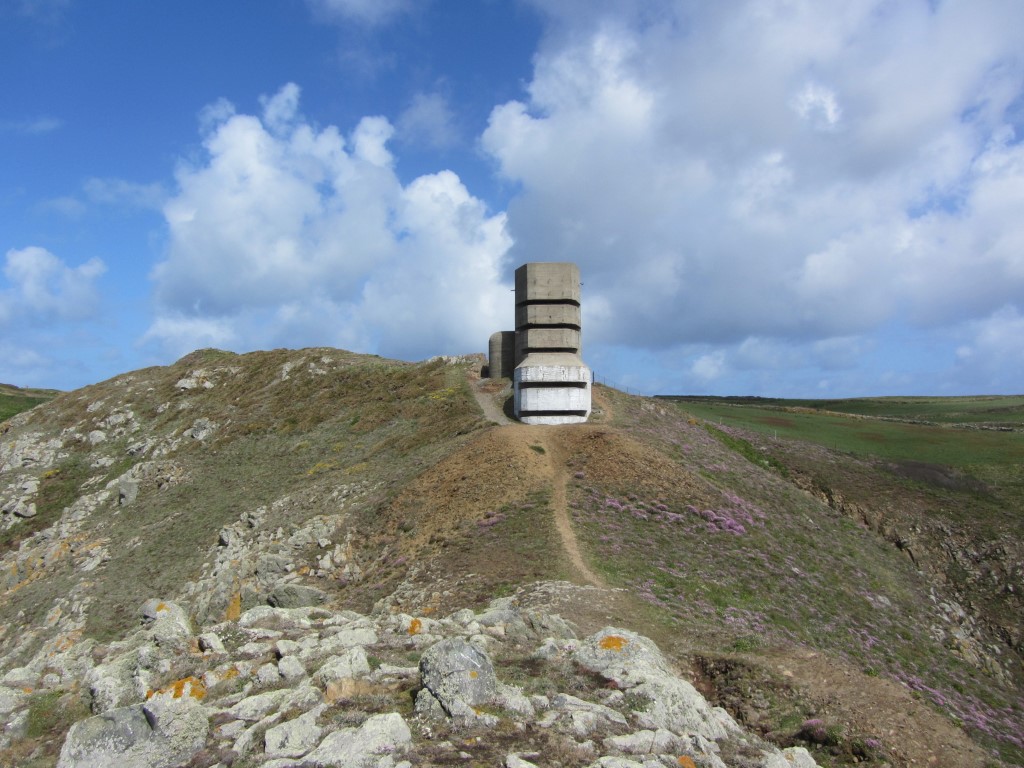
German Observation Tower at Gull Rock Torteval, one of several such towers along this stretch of coast.

A typical view along the south coast of Guernsey with many miles of first class coastal walking. This view is above Belle Elizabeth. In the distance is the spire of Torteval Cchurch.
It’s a cold Spring morning with squally overnight showers clearing away and a fine sunny day is prospect. We catch the number seven bus from St Peter Port to Fort Grey timing it with opening time at 10am. We are the first visitors of the day to this small museum on Guernsey Shipwrecks, which is housed in a Martello Tower. Leaving the museum, we follow the shore along Route de la Lague before taking a private road along to Fort Pezeries. This is the first of several German bunkers we will explore today. To the west of us on a treacherous offshore reef is the fine rock lighthouse at Le Hanois, standing a mile or so from our location. It was constructed between 1860 and 1862 and designed by the engineer James Douglass. Prior to the lighthouse there were a great number of shipwrecks in this area. Far beyond we can make out The Casquets, another rock with a lighthouse some ten miles away.
We now follow the coastal path along the south shore of Guernsey on a good path with steps. This area is the ‘Land’s End’ of Guernsey. A small diversion is taken inland to explore Pleinmont Tower, a prominent war time defence and is probably the best known German Bunker. We discover that this will be open later in the afternoon but by then we will be some distance east on our walk. Back on the coast we continue on the good path, taking our time as there was so much to see. If you are into history of the world wars then this is the place to come. My son speeds on ahead to explore the next German bunker whilst I take it at a leisurely pace taking several photographs on the way. Inland the skyline is dominated by the spire of Torteval Church. The current church was built in 1818 and stands on the site of a much earlier church. Its spire is the tallest on Guernsey and prior to the Hanois Lighthouse it was used as a sea mark.
On the coast path we soon come across a large German Gun and a network of tunnels and trenches have been restored much to my sons’ delight. East of Le Creux Maine we find a seat out of the brisk wind to have lunch. Until now, we have had the coastal path mostly to ourselves but a few walkers now pass us heading west.
For the afternoon we stay with the coast and later at a point where the path goes slightly inland we find a café selling ice creams at La Gouffre. Back on the coast we pass a party of French ramblers. We finally leave the coast at Petit Bot Bay but not before a wander down to the beach. I had originally intended catching the bus from Le Bourg but due to a road closure noted in the morning, I decide that it would be better to head further east. A road is followed inland from Petit Bot Bay then a path to join a lane up to the main road. Our timing means that it will be a long wait for the next bus on a busy road so we opt toextend our walk by turning right then left to follow a quieter lane to Mouilpieds which just happens to be under the flight path to Guernsey Airport. At Moulipieds we wait for the bus along with another group of people. It isn’t the best place to stand on such a busy road with no pavements. When the bus does arrive, it is full including the group of French ramblers we saw earlier so its standing room only for much of the way.
Cramming in three Munro’s in one afternoon.
It’s June 2015 and the weather has been quite appalling over recent days and I am setting off on a ten day trip to bag a few more Munro’s.
With an early start from Macclesfield, I head north to Scotland with very much an open mind with thoughts even of doing something low level today. From fleeting showers over Northern England and the Southern Uplands to heavier showers north of Glasgow prospects don’t seem too good but I continue north, stopping in a lay-by opposite the turning to Derrydaroch Farm just short of Crianlarich. Will it be possible to bag my last three Munro’s in this area is the question on my mind? The weather looks to be clearing up and the cloud appears to be lifting off the hills.
I’m deciding to go for it and donning full waterproof gear I set off crossing the bridge over the River Falloch then head south a short distance following the West Highland Way. A few walkers are trekking north along this path but it seems that no one is venturing up into the hills. After crossing the Allt a’ Chuilinn I’m leaving the West Highland Way and strike off south towards the spur called Stob Creag an Fhithich. The going is slow and quite squelchy and with a biting wind it’s not all that pleasant. A succession of showers pass just to the south of me and for now I stay dry. What seems like an endless ascent I eventually reach the summit of Stob Creag an Fhithich where I bump into a couple of young women from Glasgow with their dog who are slightly lost. I put them on the right track. What is now disheartening is the big descent which lies ahead of me along this very undulating and hummocky ridge. Progress will indeed be slow along this ridge leading up to Beinn Chabhair, my first of three Munro’s. It is often the case of any height gained is soon lost as I come across deep little valleys.
At a sheltered spot I stop for a quick but late lunch before making it to the 933 metre summit. At least I have a view but the biting wind means it is a fleeting visit and not a place to hang around despite it being June. I have two more Munro’s on the cards today but by now I am losing time in this rugged terrain. Heading east I descend to a col before climbing diagonally to Bealach Buidhe across pathless terrain. Beinn a’ Chroin my second Munro seems to be surrounded by cliffs with few chinks in its armour although I do spot a possible way up. Having found a path, I decide to follow this which ascends around the southern side of the cliffs with an increasing steep drop to my right. I am expecting an easy way up but I am eventually confronted by a rock step about head height and no easy way up and with no easy hand holds. It isn’t the place to have a fall. I ponder the possibility as it is likely that I will have to return this way. Placing my walking pole on the ledge above I carefully lever my way up the step and soon meet a party of walkers coming down which I will join up with towards the end of the walk. Once on the summit plateau I make for the highest point via some false summits. I am satisfied that I had reached the 942 metre summit and again don’t hang around. My main concern is that dreaded rock step on the way down. Remembering the possible alternative gap in the ring of cliffs I opt to head there but from above it isn’t easy to find. Dropping too low too early will be a big mistake. Skirting around the western spur of the mountain it is with relief to see the easy way down but this too proves quite steep but at least there is no rock step. It is then a straight forward walk across to Bealach Buidhe.
The last peak of the day is An Caisteal and the highest, topping out at 995 metres. It is now a 200 metre ascent up the rocky spur. The party that I had seen earlier are almost at the top. In a bitterly cold wind I toiled up to the top, and again I have no appetite to linger on the summit so it is just a quick photograph stop to prove that I had bagged yet another summit.
With time pressing, I am now well behind schedule. The easiest descent now is via Twistin Hill which indeed has one or two surprises up its sleeve with a gash in the ridge to cross and on its eastern side snow has drifted to around thirty feet. The other party are some half mile ahead of me and by now crossing the spur at Sron Gharbh. I follow on down the ridge with a head wind which makes my eyes water. It is even cold enough for gloves and yet this is June but it feels more like mid winter. At Sron Gharbh I decide to head directly off the ridge to a point where work is being carried out to harness the water on the Allt Andoran. Beyond that point a track has been constructed. It is a quick descent and I am pleased that the wind has dropped at lower levels. The other party has takebn a longer route for the descent and I have now almost caught them up. Crossing the Allt Andoran proves another matter and thankfully I have seen where the other party has crossed. The stream is running high and many rocks are submerged. It certainly isn’t the place to take a paddle. Safely across I soon catch up the other party who consist of a father and two adult sons. The father is tiring after doing a similar walk to the one I have done. One of the other son’s I get chatting to for the remainder of the walk. Since leaving the army, he was out on a challenge for charity to climb all the Munro’s before September but he had only just started this quest and the previous week he had been out in some atrocious weather and reading between the lines I just thought that he was being a bit too ambitious.
Well three Munro’s had been bagged after an early start from home and a three hundred mile drive I was now ready for a good rest.
Group long walk report 6th July
By Sue Thersby
Eleven East Cheshire Ramblers boarded the train at New Mills Central Station for the short journey to the start point of our linear walk in Edale. Leaving the train we followed the procession of other walkers, who were starting along the Pennine Way. There was no need for a map at this point as it was just a case of follow my leader. We all went up Jacob’s Ladder, which was named after Jacob Marshall, who created the original stepped path on the pack-horse route during the 18th century. From the cairn at the top of the steps, there was still quite a steep climb up to a division of paths. Then, the hordes went northwards, whereas we continued southwards using the “yellow-brick” road of paving stones, which line this path along the edge of Brown Knoll. This path gave us lovely views of Kinder and the valley beneath us. Reaching South Head, we joined the Pennine Bridleway for a short time, before turning to the south-west, crossing the Hayfield Road and taking the path passing Peep O’Day. Allegedly this interesting name comes from the position of the small window above the porch of the house. In the early morning sun shines through this window onto and down the stairs. From here, we climbed up passing Hills Farm and onto the moors. Descending towards Hayfield, we caught our first view of Kinder Reservoir in the distance. Our route then veered south-westward, past the radio mast and over Ollersett Moor, before going via Shedyard Clough, down to the River Goyt and eventually joining the Mid-Shires Way. From there, our route was flat along the riverside and over the Millennium Walkway. About half of its 125 yards length this walkway hugs a tall retaining wall, before running along pillars rising from the river bed. It was then just a short, steep climb back to our starting point at the station.
Long walkers weekend report 2nd-4th August at Kirkby Stephen
Written by Colin Park & Graham Bothwell
The ‘long walkers’ of the East Cheshire Ramblers recently journeyed north to the Howgill Fells and the westernmost part of the Yorkshire Dales for three days of walking.
On the Friday, the group ventured up onto the Howgill Fells and set out from Sedbergh to make the steady ascent over Arant Haw and Calders to reach The Calf which at 676 metres is the highest point in this group of hills. The return was made over White Fell Head and quiet country lanes.
For the Saturday, Graham Bothwell led a linear moorland walk starting out from the small village of Keld in Upper Swaledale and the group followed a paved path heading towards Kisdon Force and used a wooden bridge to cross the River Swale, before continuing above Cotterby Scar and on towards Ravenseat Farm. On leaving the farm using an old stone bridge, we followed a minor road, track and then paddled across a shallow ford to use a right of way alongside Ney Beck. After passing a shooting hut the group left the footpath, headed across rough ground towards a prominent pillar of stones, then a ruined shelter before approaching a boggy section of the route. On negotiating this we headed towards White Mossy Hill and headed to highest point of the day at Nine Standards Rigg (662 metres). This summit is crowned with nine large cairns which once stood up to four metres high. Their origin is uncertain but they are marked on old maps dating back to 1738 and it is thought that they are much older. One theory is that they marked the boundary between Westmorland and Swaledale. From the summit, a gradual descent was made towards Hartley and before reaching the village we left the Coast to Coast route to walk along a disused railway over the substantial Merrygill and Podgill Viaducts. Leaving the old railway the group walked via fields and alongside the River Eden to return to Kirkby Stephen.
With a met office weather warning in place for the Sunday, the decision was made to do a low level walk rather than heading up onto Wild Boar Fell and Swarth Fell, an area of high exposed moorland with no shelter. Colin Park led a walk north from Kirkby Stephen on a fine sunny morning and followed a series of field paths passing through the quiet village of Winton and passing close to Kaber and Brough Sowerby to reach Church Brough. A break was taken here to visit the ruinous Brough Castle which is in the care of English Heritage. The castle was built by William Rufus around 1092 and stands on the site of the old Roman Fort called Verterae, one of a chain of forts between York and Carlisle. After a wander around the ruins the group paused for refreshments and ice creams.
Continuing west, we now headed for the village of Great Musgrave for lunch in the peaceful churchyard overlooking the River Eden. The return was via lanes and field paths passing through the villages of Little Musgrave and Soulby with shower clouds beginning to threaten as we entered Kirkby Stephen.
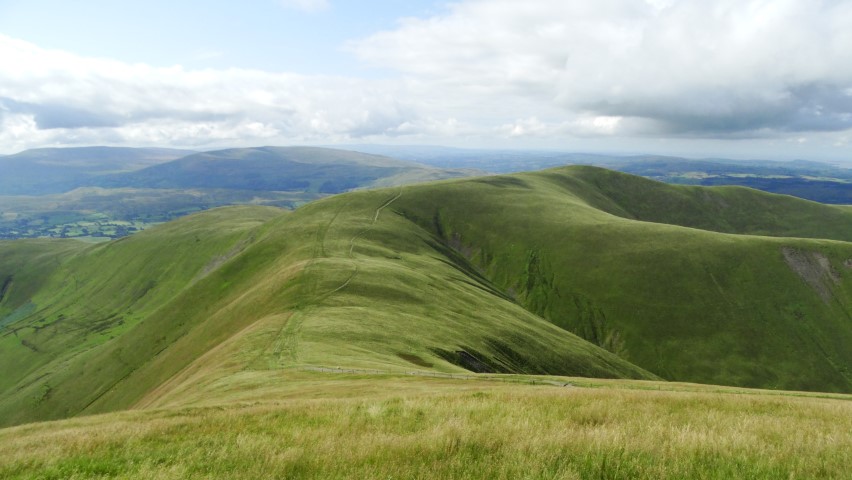
The rolling Howgill Fells. The group followed this ridge on the Friday walk and this view looks south from Calders.

Kirkby Stephen Parish Church near the start of Sunday’s walk. It’s hard to believe that there is a weather warning in force for thunderstorms.
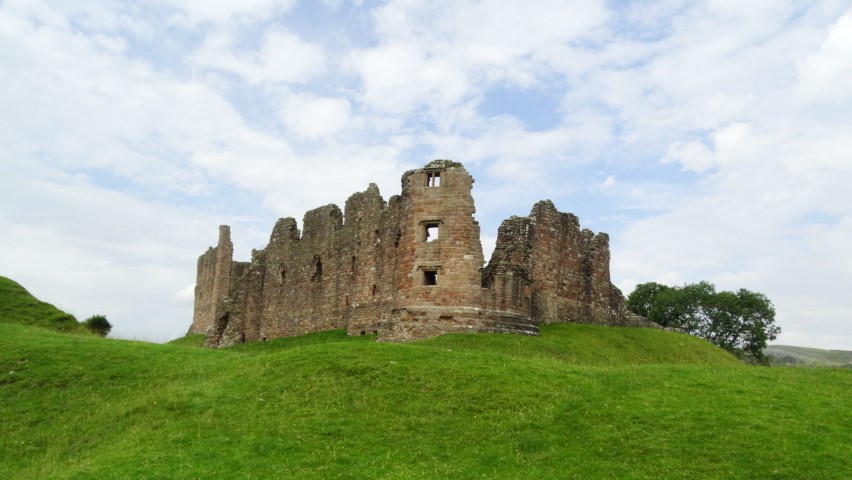
Brough Castle – a stopping point for tea/coffee and a vast range of locally made ice creams. (Sunday’s walk).
Group walk report 3rd July
By Sue Thersby
Chinley was the start point for a recent walk by the East Cheshire Ramblers. Ten walkers set off under sunny skies with a promise of warm weather. Chinley is a large, busy village on the western edge of the Peak District National Park. Originally it was part of the Royal Forest of the Peak and consisted of little but a few isolated farms until the 17th century. The industrial revolution significantly altered the village with the construction of three mills along the Black Brook, which runs through the village, followed by the Peak Forest Tramway completed in 1806 (a crude railway which used horse-drawn wagons to carry stone). We descended to the tramway to begin our walk and went along it as far as Chapel Milton. Having crossed the Chapel en le Frith road, we made our way to Wash via field paths and then on to Bowden Hall. The history of the hall is obscure but there was a building there as early as 1477. Later in its history it was the home of a Wormhill quarry owner. It has lovely views to the west. From here we crossed the Sheffield Road before having a morning break. The route then continued to Bagshaw and from here we climbed quite steeply to Stonyford. Having struggled to find a route along field paths during the reconnoitre we opted to take the road to join a track which runs parallel to the aforementioned Sheffield Road before crossing it again and joining the Pennine Bridleway at the bottom of Rushup Edge. We followed this for about two and a half miles to the bottom of South Head (1621 feet), taking advantage of some excellent views to have our lunch break on the way. Because of the hot weather and further climbing to be done, we contoured round the base of South Head. A little further on, we left the Pennine Bridleway to cross the Hayfield Road and resume our walk in a westerly direction, passing Peep o’Day. Allegedly this interesting name comes from the position of the small window above the porch of the house. In the early morning sun shines through this window onto and down the stairs. From here, we climbed Chinley Churn and, after enjoying the views from our vantage point, we descended back to the village of Chinley, finding refreshments at a local café.
Group walk report 29th June
It was a hot and humid day for this thirteen mile long walk for the East Cheshire Ramblers starting out from the village of Ripponden. The first part of the walk followed the wooded valley of the River Ryburn before making a short but steep ascent to the dam at Ryburn Reservoir. Completed in 1933, the reservoir is operated by Yorkshire Water and is the lower of two reservoirs built in the valley. Both reservoirs supply water to the City of Wakefield.
Above the southern shore of the reservoir a stop was made at a picnic area for a morning coffee break before making the ascent up onto Blackwood Edge. Here we joined the Blackwood Edge Road westwards which is a moorland track. A diversion was made to reach the rounded summit of Dog Hill (435 metres). From here, moorland paths were followed west over Rishworth Moor to join the path which runs alongside Rishworth Drain which is a leat which contours around the hillside and acts as a catchment stream for the nearby Great Withins Reservoir. It was a good spot to stop for lunch as there was just enough breeze to make it pleasant.
For the afternoon leg of the walk we descended on the moorland path close to Rag Sapling Clough to reach and cross the A58 at New Gate End Bridge. A gradual ascent followed over Soyland Moor where our walk continued to the hill called Manshead End (417 metres) and time for another break to admire the views.
The slightly lower Great Manshead Hill was next on our route before joining the Calderdale Way and later descending to Mill Bank, a small village which has a rich industrial history. The valley through which runs the fast flowing Lumb Beck was once a hive of industry with several water mills. Industries included cotton, fine silk woollen worsted cloth and spinning but the last textile mill in the valley finally closed in the 1970’s. At one time, over four hundred local people were employed in these industries but times were hard especially when disastrous fires burnt the mills down.
With another short but steep ascent followed by a gradual descent across fields we were soon in Ripponden and timed it nicely for afternoon tea and c
ake in Stanley’s Kitchen.

Starting point was close to the Old Bridge Inn in Ripponden which is claimed to be the oldest hostelry in Yorkshire.
Group walk report 10th July
By Paul Simms
The Peak Pilgrimage is a 39 mile long-distance footpath from the Church of the Holy Cross in Ilam to St Lawrence’s church in the plague village of Eyam, taking in ten other churches on the way. East Cheshire Ramblers are undertaking a series of circular walks to trace this pilgrimage route and we did the fourth of these recently.
A small group of Ramblers set off from the top of Lathkill Dale on an overcast day in mid-July that quickly brightened up and had us shedding fleeces and jackets and donning sun hats. Many spring wildflowers were still in evidence including the lovely blue Jacob’s Ladder.Also in the dale is much evidence of historical industry with mine tunnels and shafts, screes from quarrying, weirs and mill stones, and the pillars of an aqueduct that supplied a mill for pumping water out of the old mine workings.
The limestone of the dale is some 340 million years old, laid down in shallow tropical seas and coral lagoons with plenty of fossils to see when you know what to look for. At the village of Over Haddon, the stones of the Victorian church of St Anne’s have lots of crinoids and brachiopods. Leaving the dale here we set off across farmland and over many stiles to reach Magpie Mine.
Magpie Mine is the most complete example of lead mining in the Peak District. The picture shows some of our party enjoying their sandwiches in front of the old engine house where a Cornish beam engine was installed in 1840, again to pump water out of mine. Disputes over the rights to mine the lead seams led to the deaths of three miners at adjacent workings in 1833 and their widows put a curse on Magpie Mine which remains to this day!
From the mine we headed back across the fields to Bagshaw Dale and so to our start point.
For more details of the Peak Pilgrimage go to peakpilgrimage.org.uk. For information about lead mining in the Peak District go to peakdistrictleadminingmuseum.co.uk.
Our visit to the Blackden Trust
Brian Griffiths has recently led the first of three planned visits by our group to The Blackden Trust near Goostrey.
The Blackden Trust really is a “Hidden Gem” and was only ‘discovered’ by the group whilst out on a ramble in the area earlier in the year and not one of the 20 of us had heard of it until a few months ago.
A short walk along the paths and lanes around Goostrey led us to Blackden where famed local author Alan Garner lives. Already living in the 15th century Toad Hall he rescued the 16th century Old Medicine House from demolition in Wrinehill near Crewe. Purchasing it for £1 he organised its reconstruction at Blackden.
We were all thoroughly entranced by the stories told by his daughter Katharine of growing up there, and the history of the place and the buildings told by several volunteers.
Afterwards we all enjoyed tea and cakes in their marquee, especially Andy who wolfed down 2 slices!
I don’t want to spoil it for the following 2 groups so will leave it to Colin Park to provide a more detailed account after his visit. At the time of writing we have only 1 place left for the final visit on 24th August. However there are still places left on their public tours for anyone interested in this absolutely fascinating “Hidden Gem”.Just Google Blackden Trust.
Brian Griffiths
As a footnote Colin Park will lead a visit on the 21st of August and Tony Littler will lead the visit on the 24th of August. Both visits will be preceded by an optional morning walk of around 5-6 miles and full details will appear on our website prior.
ECR Weekend Away to Ilkley – 15th / 16th June 2019
Every year, East Cheshire Ramblers organises one or two weekends away and in June they went to the delightful Yorkshire spa town of Ilkley. Thirty seven people took part, with the majority staying in Craiglands Hotel next to Ilkley Moor. There were 6 walks of various lengths over the weekend. On Saturday, they were 3 walks in the Bolton Abbey area. The short walk (7 miles) stayed within the Bolton Abbey estate, which is privately owned by the Duke of Devonshire. They enjoyed a leisurely walk along the river, admiring the curlews and marvelling at the sand martins racing across the river and disappearing into small holes in the riverbank. They stopped for lunch at Bolton Priory ruins, which was perfect timing to watch a wedding party coming out of the adjoining 12th century church. On their return they came across a full size toy tractor which most of them couldn’t resist having a play on.
The medium (9 miles) and long walkers (13 miles) set off separately through the Valley of Desolation and across Barden Fell to Simon’s Seat. While the medium walkers dropped down to the Valley of the River Wharfe and walked back along the river, the long walkers covered Howgill Lane, High Skyreholme, Parceval Hall, Trollers Gill, Harrington and Appletreewick, returning along the Dales Way past Barden Tower and The Strid back to Bolton Abbey.
On Sunday all the walks started from the hotel and climbed up to Ilkley Moor. It was quite a humid day and having had a late cloudburst on the previous day, it was interesting to see how each rambler interpreted the weather forecast and outfits ranged from shorts and short-sleeves to full waterproof gear! In the event, the weather was wonderful.

Will it be hot or cold, dry or wet. A conflicting weather forecast for the Sunday walk meant different types of clothing to wear.
All the walks passed Ilkley Tarn, which was previously lit with a fountain and the scene of band concerts but is now a peaceful wildlife haven. They went on to White Wells, a former spa bath, which now has a small café. The bath was outdoors when built in the 18th century but is now enclosed with interesting interpretation boards on the history of Ilkley as a spa town. At this point the walks went their separate ways.
The short walkers headed east towards the famous hanging stone, known as the Cow and Calf. Legend has it that the calf was split from the cow when the legendary giant Rombald was fleeing an enemy and stamped on the rock as he leapt across the valley. Ilkley Moor was originally known as Rombalds Moor, but thanks to the famous song “On Ilkley Moor Baht ‘at” it is always known as Ilkley Moor. As the short walkers continued their walk, they passed the Little Skirtful of stones and the Great Skirtful of stones: stones apparently carried by the Giant’s wife in her skirt and dropped as she was pursuing him across the moor. Yes, you guessed it, she was the enemy! Ilkley Moor is well known for its archaeology and the short walkers also passed the Twelve Apostles, a ring of Bronze Age standing stones near the meeting of 2 ancient routes. The medium and long walkers followed the millennium way to the Swastika stone with its engraving of a swastika shape. There is debate as to whether it dates from the Bronze, Neolithic or Roman ages. The medium walkers followed the Dales High Way to Addingham and then back along the River Wharfe to Ilkley. The long walkers walked along the northern edge of the moor with spectacular views extending over Silsden as they turned south and descended through the Glen to reach Sunnydale Reservoir built in the 19th century for the local area but now part of Yorkshire Water. Returning over the moor they had extensive views of Keighley, Bradford, Leeds and the intervening settlements before they reached the summit of the moor and the northern aspect returned with clear views of the Menwith Hill early warning system. They returned via the Cow and Calf Rocks.


